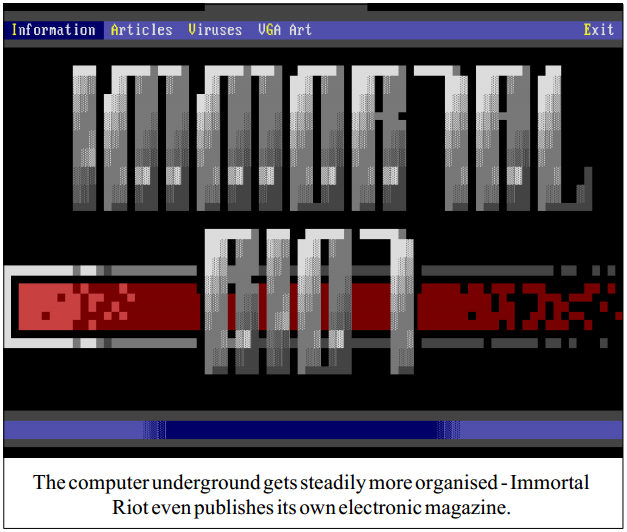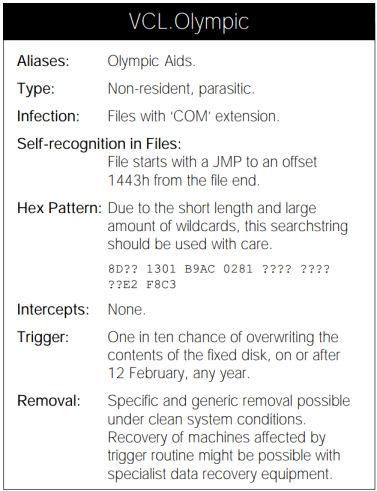Newsfeed
Nachrichtenbote
Whenever there's a global sporting event, we get questions about the "cyber" angle. Could an event like The Olympics be targeted by malware outbreaks, or maybe DDoS attacks?
And while there are some real security concerns, most coverage of cyber attacks during Olympics end up to be incorrectly reported or just hype.
This is not a new phenomenon. Let us reprint an article from 20 years ago. The below analysis was first published in the March 1994 edition of the Virus Bulletin magazine. Enjoy!
—————
Olympic Games
Virus Bulletin, March 1994
Analysis by Mikko Hypponen
A new virus, known as Olympic (aka Olympic Aids), has
featured prominently on the television, on the radio, and in
the newspapers of Northern Europe since the beginning of
February. Its newsworthy factors are its Olympic-theme
activation routine, and suspicions that it had infected the
computer systems of the Lillehammer 1994 Winter Olympics.
Fortunately this was not the case.
Despite being reported in the wild in Norway, Olympic is
not of Norwegian origin: it is made in Sweden by a new
virus group which calls itself Immortal Riot.
Into the Underground
Swedish soil seems to provide particularly fertile ground for
raising virus groups: clans like Beta Boys, Demoralized
Youth, and the Funky Pack of Cyber Punks have been active
in Sweden in the past. The latest group of virus writers,
Immortal Riot, seems to consist of four members, known
only by their aliases, or handles. So far, the group has
published and distributed about thirty viruses, most of which
are new variants of existing strains. The viruses thus far seen
are not examples of technical brilliance; quite the opposite.
Most simply crash the computer, or manifest their presence
in some other obvious way.
Immortal Riot also publishes an electronic magazine, 'Insane
Reality', containing articles by the group members and their
associates, source codes of viruses, and back-patting and
back-stabbing of other members of the virus community. The
group seems to be little more than an ego trip for this gang of
teenagers - it seems to be cool to be a virus writer.

Virus Operation
Olympic is a fairly typical COM file infector, which does not
remain in memory, and spreads only when an infected file is
executed. Its method of searching for files for infection is not
very efficient. Once a number of files on the hard disk have
been infected, it may take half a minute to find a new victim:
such a slowdown is likely to make the virus easier to spot.
When it finds a suitable candidate for infection, the virus
first checks the size of that file to ensure that the infected
code will be greater than 64 Kbytes, the largest permissible
size for a COM file. The first bytes of the file are checked for
a jump construct which the virus is about to insert. If found,
the virus considers the file already infected and starts to
search for another victim. This process is repeated until five
files are infected.
The virus does not check the internal structure of the host file
when it infects. Thus, EXE files with a COM extension will
be infected by the virus. When such a corrupted file is
executed, the virus will infects other files on the machine,
but is unable to return control to the original program. In
most cases, the machine will crash.
The infection process consists of storing the original first
three bytes of the file at the file end, replacing them with a
jump to a setup routine, which the virus adds to the end of
the file. An encrypted version of the virus code is appended
to the end of the file, and, finally, the virus adds a short
plain-text note and the decryption routine.
Olympic uses a single pseudo-random variable key based on
infection time to encrypt its code. The routine uses either the
SI or DI register as work-registers in the decryption loop,
alternating between infections. Thus, there are only 25
constant bytes between different virus generations. These are
located in two different parts of the virus. The encryption
method is not truly polymorphic, and is unlikely to cause
problems for anti-virus vendors.
Olympic can infect files which have the DOS Read-Only
attribute turned on, and will also restore the date and time
stamps of infected files. However, files grow in size by 1440
bytes, which is visible in the directory listing. The virus has
no directory-stealth routines, as it does not stay resident.
Olympian Trigger
The virus was programmed to trigger on the day after the
start of the 1994 Winter Olympics (12 February), and has a
one-in-ten chance of activating after this date. Dice
throwing is done by checking whether the system timers
hundredth-of-seconds field is below 10. The virus does not
check the current year. If the trigger conditions are not met,
the virus returns control to the host file.
On activation, the virus draws the Olympic circles on the
screen, displaying comments on the Games and its mascots,
Haakon and Kristin. Next, it overwrites the first 256 sectors
of the first hard disk in the system. To ensure destruction, the
virus disables Ctrl-C and Ctrl-Break checking during the
destruction routine. Finally, the machine hangs.

Much of Olympics code resembles that of viruses generated
with VCL, up to the point of the standard VCL-like note; a
short message in the end of the virus, which is not displayed
at all. The virus note text reads: Olympic Aid(s) `94 (c)
The Penetrator. This virus is probably based on VCL-
created code, modified to avoid detection by some scanners.
As the virus displays a picture before starting to overwrite
the disk, aware computer users might be able to switch the
machine off before the virus has a chance to overwrite data
areas, making recovery much easier.

On 07/02/14 At 01:52 PM
Weiterlesen...
And while there are some real security concerns, most coverage of cyber attacks during Olympics end up to be incorrectly reported or just hype.
This is not a new phenomenon. Let us reprint an article from 20 years ago. The below analysis was first published in the March 1994 edition of the Virus Bulletin magazine. Enjoy!
—————
Olympic Games
Virus Bulletin, March 1994
Analysis by Mikko Hypponen
A new virus, known as Olympic (aka Olympic Aids), has
featured prominently on the television, on the radio, and in
the newspapers of Northern Europe since the beginning of
February. Its newsworthy factors are its Olympic-theme
activation routine, and suspicions that it had infected the
computer systems of the Lillehammer 1994 Winter Olympics.
Fortunately this was not the case.
Despite being reported in the wild in Norway, Olympic is
not of Norwegian origin: it is made in Sweden by a new
virus group which calls itself Immortal Riot.
Into the Underground
Swedish soil seems to provide particularly fertile ground for
raising virus groups: clans like Beta Boys, Demoralized
Youth, and the Funky Pack of Cyber Punks have been active
in Sweden in the past. The latest group of virus writers,
Immortal Riot, seems to consist of four members, known
only by their aliases, or handles. So far, the group has
published and distributed about thirty viruses, most of which
are new variants of existing strains. The viruses thus far seen
are not examples of technical brilliance; quite the opposite.
Most simply crash the computer, or manifest their presence
in some other obvious way.
Immortal Riot also publishes an electronic magazine, 'Insane
Reality', containing articles by the group members and their
associates, source codes of viruses, and back-patting and
back-stabbing of other members of the virus community. The
group seems to be little more than an ego trip for this gang of
teenagers - it seems to be cool to be a virus writer.

Virus Operation
Olympic is a fairly typical COM file infector, which does not
remain in memory, and spreads only when an infected file is
executed. Its method of searching for files for infection is not
very efficient. Once a number of files on the hard disk have
been infected, it may take half a minute to find a new victim:
such a slowdown is likely to make the virus easier to spot.
When it finds a suitable candidate for infection, the virus
first checks the size of that file to ensure that the infected
code will be greater than 64 Kbytes, the largest permissible
size for a COM file. The first bytes of the file are checked for
a jump construct which the virus is about to insert. If found,
the virus considers the file already infected and starts to
search for another victim. This process is repeated until five
files are infected.
The virus does not check the internal structure of the host file
when it infects. Thus, EXE files with a COM extension will
be infected by the virus. When such a corrupted file is
executed, the virus will infects other files on the machine,
but is unable to return control to the original program. In
most cases, the machine will crash.
The infection process consists of storing the original first
three bytes of the file at the file end, replacing them with a
jump to a setup routine, which the virus adds to the end of
the file. An encrypted version of the virus code is appended
to the end of the file, and, finally, the virus adds a short
plain-text note and the decryption routine.
Olympic uses a single pseudo-random variable key based on
infection time to encrypt its code. The routine uses either the
SI or DI register as work-registers in the decryption loop,
alternating between infections. Thus, there are only 25
constant bytes between different virus generations. These are
located in two different parts of the virus. The encryption
method is not truly polymorphic, and is unlikely to cause
problems for anti-virus vendors.
Olympic can infect files which have the DOS Read-Only
attribute turned on, and will also restore the date and time
stamps of infected files. However, files grow in size by 1440
bytes, which is visible in the directory listing. The virus has
no directory-stealth routines, as it does not stay resident.
Olympian Trigger
The virus was programmed to trigger on the day after the
start of the 1994 Winter Olympics (12 February), and has a
one-in-ten chance of activating after this date. Dice
throwing is done by checking whether the system timers
hundredth-of-seconds field is below 10. The virus does not
check the current year. If the trigger conditions are not met,
the virus returns control to the host file.
On activation, the virus draws the Olympic circles on the
screen, displaying comments on the Games and its mascots,
Haakon and Kristin. Next, it overwrites the first 256 sectors
of the first hard disk in the system. To ensure destruction, the
virus disables Ctrl-C and Ctrl-Break checking during the
destruction routine. Finally, the machine hangs.

Much of Olympics code resembles that of viruses generated
with VCL, up to the point of the standard VCL-like note; a
short message in the end of the virus, which is not displayed
at all. The virus note text reads: Olympic Aid(s) `94 (c)
The Penetrator. This virus is probably based on VCL-
created code, modified to avoid detection by some scanners.
As the virus displays a picture before starting to overwrite
the disk, aware computer users might be able to switch the
machine off before the virus has a chance to overwrite data
areas, making recovery much easier.

On 07/02/14 At 01:52 PM
Weiterlesen...
